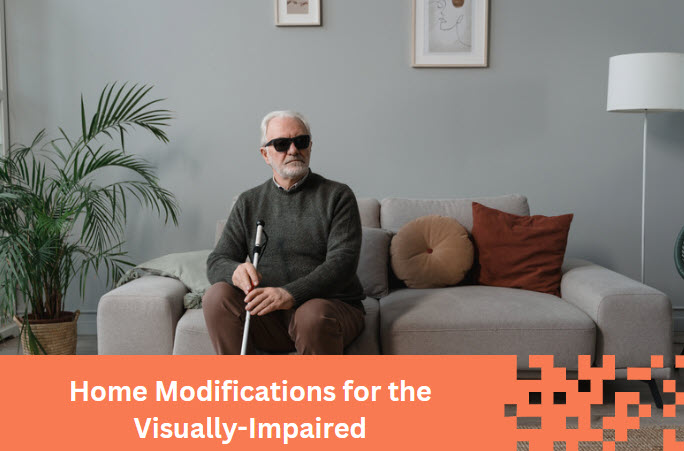As a visually impaired individual, moving through an unfamiliar space can feel like attempting to unravel the complexities of a labyrinth with no guidance. Each step taken into uncharted territory is fraught with trepidation and uncertainty, as one must contend with the possibility of colliding against objects or obstructions in their path and the daunting prospect of going up the stairs without any visual cues. This daily struggle requires immense fortitude and resilience, for it necessitates that individuals living with blindness confront their fears head-on and persevere despite seemingly insurmountable obstacles blocking their way forward.

Imagine navigating through a dense forest at night with no light to guide your way. Each tree is a potential obstacle, similar to how furniture or other items might obstruct the path in an unfamiliar home. The forest floor could be uneven, much like unexpected steps or thresholds in a house, and overhanging branches can be compared to low-hanging light fixtures or other head-level obstacles.
The kitchen might feel like a chemistry lab, where one wrong move could lead to a dangerous situation – like mistaking acid for water, or in the home context, turning on a stove burner without realizing it.
Finding the bathroom in an unfamiliar home can be like looking for a hidden treasure chest on a vast, uncharted island. Even when you see it, there’s still the challenge of figuring out where everything is, like trying to unlock the treasure chest without the key.
Consistent organization, clear pathways, and assistive technologies can be crucial for blind individuals. It’s like providing a well-detailed map, a reliable flashlight, and a compass for that dense forest or uncharted island, making what could be a daunting and risky journey significantly more manageable and safer.
For this reason, using 3D visual representations in a medical setting or voice-controlled home automation technology could be seen as major advancements that can significantly improve the quality of life for blind individuals.
However, as stated in various studies and reports, only a small percentage of individuals with visual impairment have the proper training or access to these technologies. This leaves many individuals with visual impairment facing daily struggles when navigating the spaces in which they live. It is crucial to prioritize the accessibility and usability of assistive technologies, especially for those who could arguably benefit from them the most, such as individuals with speech and visual impairments. By providing easy access to assistive technology and its proper training, we can help alleviate the daily struggles that blind individuals may face when living at home.
Systematic Organization is Key
Living at home as a blind person can present daily struggles such as difficulties with navigation, object recognition, and social interaction. Navigating familiar spaces can be challenging as simple tasks such as finding the bathroom or kitchen might feel like searching for a treasure chest on an uncharted island.
For a blind person, a well-thought-out and systematic home organization is essential. Since vision is not available for navigation or locating items, other senses, and memory play a crucial role in day-to-day activities. Here are some of the most necessary modifications:
- Consistent Organization: Everything should have a designated place and be returned consistently. This allows the person to find items easily through memory.
- Clear Pathways: Pathways should be clear of clutter and objects that could cause trips or falls. This includes securing or removing rugs and securing any loose cables.
- Tactile Indicators: Tactile indicators can help identify different rooms, appliances, or items. This might include different textures on door handles or other types of flooring for different rooms. Braille labels can also be used.
- Technology: Assistive technologies can be extremely helpful, including talking clocks, timers, and appliances; voice-activated devices; and specialized computer and phone software.
- Safety in the Kitchen and Bathroom: These areas can pose particular challenges. In the kitchen, tactile markers on stove dials and other appliances can be helpful, as can organization systems for food and utensils. In the bathroom, consider installing grab bars around the toilet and in the shower or tub, and possibly a shower chair or bench.
- Sound Orientation: Using sound for orientation can be helpful. For example, a small water feature or clock in a room can provide an audio cue that helps navigation.
- Stair Safety: Handrails should be installed on both sides of metal staircases. Tactile or audio indicators can mark the top and bottom of stairs.
- Furniture: Furniture with rounded edges can prevent injuries, and furniture should be arranged consistently and not moved around.
- Doorways: To avoid bumping into open doors, it’s helpful to always fully open or fully close doors.
The key principle is creating a predictable and consistent environment that can be navigated through memory and other senses. It’s also important to involve the person living in the space in planning and decision-making to ensure the modifications meet their specific needs and preferences. An occupational therapist or a specialist in visual impairment can provide valuable guidance. Living at home as a blind person can present daily struggles, but many modifications and improvements can be made to create a safe and accessible environment. By implementing changes such as lighting, tactile indicators, assistive technology, safety measures in the kitchen and bathroom, sound orientation cues, handrails with proper height on stairs, furniture with rounded edges, and consistent doorways, it’s possible to create a home that is both safe and comfortable for people living with blindness. Assistive technologies can be extremely helpful for blind people at home, including talking clocks, timers, specialized software, and voice-activated devices to facilitate daily tasks.
It is important to create a comfortable and accessible environment for all people with disabilities living at home, with modifications based on their specific needs and preferences, like an assistive wheelchair ramp for people with mobility issues. Additionally, considering the Principles of Universal Design can help create a home environment that is accessible and intuitive for people with varying abilities. Living at home as a blind person poses unique challenges, but with careful planning and modifications, creating an environment that maximizes independence and safety is possible.

In this labyrinth of life, where light often fails to penetrate the dense canopy of the unknown, the visually impaired valiantly continue their journey. To them, an unfamiliar home feels like an intricate maze, a dense forest at night, or an uncharted island. Within these metaphors, we glimpse the enormity of their challenges – each piece of furniture or unexpected step becomes a towering tree in the dark, the kitchen morphs into a risky chemistry lab, and the simple task of locating a bathroom transforms into a treasure hunt on an expansive, unmarked island.
Yet, just as tools and knowledge can guide a traveler safely through a forest or aid in discovering hidden treasure, so can specific home modifications and assistive technologies illuminate the path for visually impaired individuals. By embracing systematic organization, clear pathways, tactile indicators, assistive technologies, and safety measures, we can transform the dense, unlit forest into a familiar park, the hazardous chemistry lab into a safe kitchen, and the vast, uncharted island into a comfortably navigable home.
However, these modifications are not a one-size-fits-all solution. Each person’s needs and preferences must guide the creation of a comfortable, accessible environment. We also must remember that access to these modifications and technologies is not universal. There is a dire need to democratize this access and provide necessary training to ensure that no one is left navigating their own home like a labyrinth in the dark.
In this effort, every individual, institution, and community holds a piece of the puzzle – the comprehensive solution to making all homes fully accessible and safe for those living with blindness. By piecing together this puzzle, we can offer a flashlight, a map, and a compass to our visually impaired friends and family members, making their journey through the labyrinth of life that much more manageable and their homes truly a safe haven.